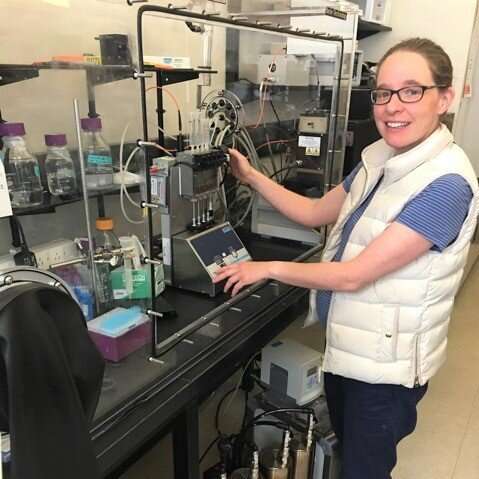Preventing colorectal cancer and stillbirths

Characterizing a tiny protein—determining its shape and what it does—was the first step taken by Dr. Kirsten Wolthers and her colleagues in their effort to learn more about a very common molecule that is implicated in a wide range of human ailments.
Wolthers used the Canadian Light Source (CLS) at the University of Saskatchewan to study flavodoxin. This protein is produced by all sorts of bacteria and some algae, she explained, including the bacteria associated with influenza, H. pylori, E. coli and even appendicitis.
Of particular interest to the associate professor from the University of British Columbia is the flavodoxin produced by Fusobacterium nucleatum, an oral bacteria found naturally in the human mouth that plays a role in periodontal disease and gingivitis.
"What makes it so interesting is that what's been emerging in the last 10 years or so are links between F. nucleatum and colorectal cancer and pre-term or stillbirths," she said. In some studies, mice given oral F. nucleatum have shown a higher-than-normal incidence of pre-term births. Because flavodoxin is known to be essential for the lifecycle of the bacteria, it is seen as a potential target for a controlling growth of the bacterium.
"The question we asked was, can we find a chemical molecule that will bind to the flavodoxin to block its function and inhibit the growth of the bacteria?"
Using X-ray diffraction techniques at the CLS, the researchers were able to generate diffraction patterns they could piece together to build a complete image of the protein. They then compared the flavodoxin produced by F. nucleatum to the flavodoxin produced by other kinds of bacteria. The work was published in the journal Protein Science.
"What we found was that its characteristics were typical of the flavodoxin you'd find associated with other bacteria, but with small variations," Wolthers said. The role of the protein is to act like a conduit, passing electrons from one protein to another but for some reason, the flavodoxin produced by F. nucleatum has less affinity for those electrons.
Wolthers said her work with flavodoxin was just the first step on a long research road which will include looking at various enzymes produced by F. nucleatum to also determine their function relative to the bacteria, again with the aim of using them as drug targets to disrupt the bacteria growth.
There are many applications for this research and, in years to come, she hopes for the creation of a drug treatment that can be combined with chemotherapy "to improve outcomes for colorectal cancer patients."
More information: Robert G. Mothersole et al. Structural insight into the high reduction potentials observed for Fusobacterium nucleatum flavodoxin, Protein Science (2019). DOI: 10.1002/pro.3661
Provided by Canadian Light Source


















